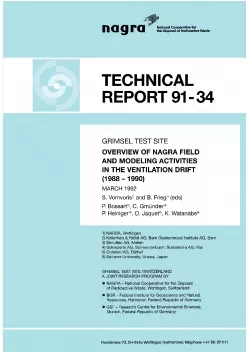
Technical Report NTB 91-34
Grimsel Test SiteOverview of Nagra field and modeling activities in the ventilation drift (1988 – 1990)
The first phase of the Ventilation Test (VE) in the Grimsel Test Site (GTS) was mainly carried out by "GSF-Forschungszentrum für Umwelt und Gesundheit GmbH, Institut für Tieflagerung" between 1983 and 1987. During the phase 2 of the VE (1988 -1990) Nagra participated actively in this test, contributing to the program with complementary field work and model development.
A short overview of Nagra's field-and modeling work as well as the corresponding results is presented in this report. Structural remapping of the ventilation drift assisted in an improved understanding of the flow path geometry. The effects of the observed heterogeneity of the deformation structures on water inflow variations into the drift and on the approach for macropermeability estimation are evaluated. Complementary methods for water inflow measurements are presented, with the emphasis on the newly developed evaporation-measurement method, where the evaporation rate at discrete points at the drift surface can be measured. Finally, highlights of the drilling campaign and the related hydrogeological tests are presented in chapter four. The objective of these tests was to investigate the geometry and deformation of the shear zone observed in the drift as well as to provide a hydrogeological characterisation of this discontinuity.
The modeling work was twofold: a validation experiment, where a prognosis of interval pressures is made prior to the drilling and compared to the results; the further development of inverse methodology in conjuction with geostatistical analysis. Both approaches give valuable information about the permeability variations in tectonically different deformed granitic host rocks.
The hydraulic conductivity and transmissivity derived by the different methods is compared in the last chapter. All methods converge to a permeability in the shear zone about one order of magnitude higher than that of the matrix. The latter however, especially if derived by the classical ventilation tests, may be affected by the drying out of the drift wall and may underestimate the actual saturated matrix permeability value. As a concluding remark, it appears that ventilation tests for the estimation of macropermeability (granitic host rocks), are best suited if inflow fluxes are of the order of 1 mg∙m-2∙s-1.
